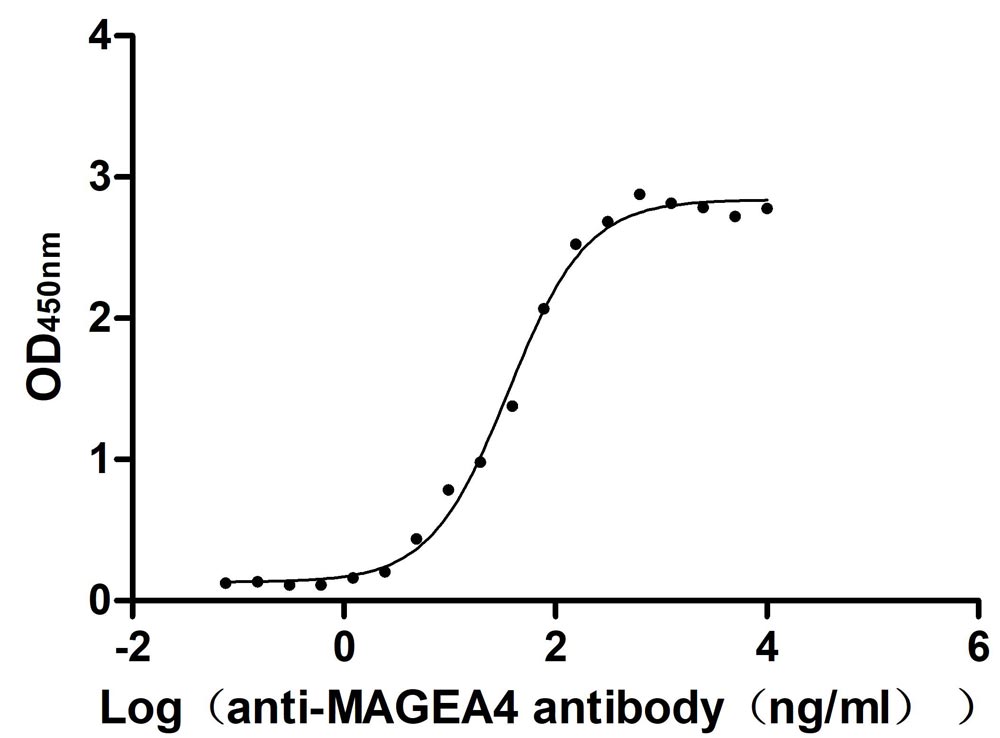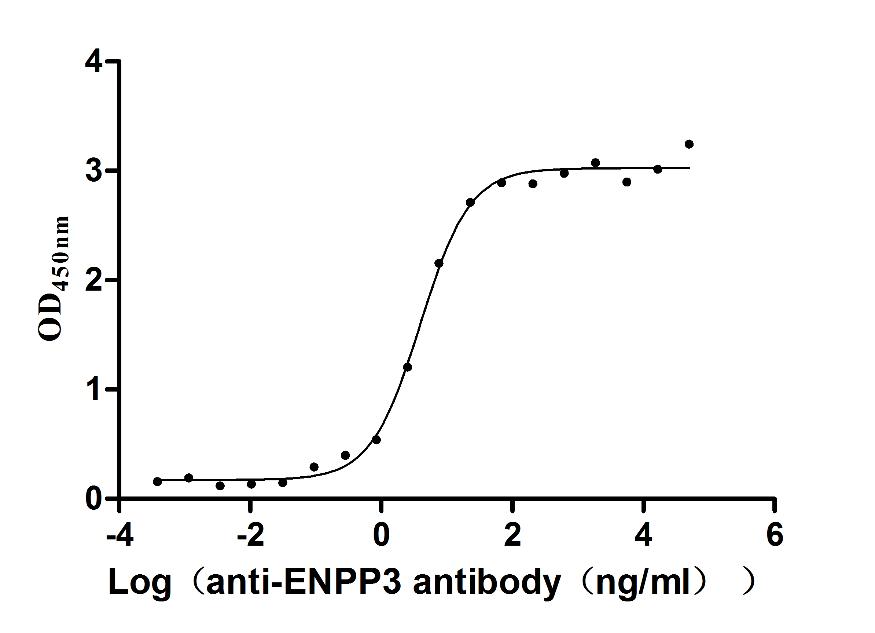Recombinant Arabidopsis thaliana Transcription factor PIF1 (PIF1)
-
货号:CSB-YP812763DOA
-
规格:
-
来源:Yeast
-
其他:
-
货号:CSB-EP812763DOA
-
规格:
-
来源:E.coli
-
其他:
-
货号:CSB-EP812763DOA-B
-
规格:
-
来源:E.coli
-
共轭:Avi-tag Biotinylated
E. coli biotin ligase (BirA) is highly specific in covalently attaching biotin to the 15 amino acid AviTag peptide. This recombinant protein was biotinylated in vivo by AviTag-BirA technology, which method is BriA catalyzes amide linkage between the biotin and the specific lysine of the AviTag.
-
其他:
-
货号:CSB-BP812763DOA
-
规格:
-
来源:Baculovirus
-
其他:
-
货号:CSB-MP812763DOA
-
规格:
-
来源:Mammalian cell
-
其他:
产品详情
-
纯度:>85% (SDS-PAGE)
-
基因名:PIF1
-
Uniprot No.:
-
别名:PIF1; BHLH15; EN101; PIL5; At2g20180; T2G17.2; Transcription factor PIF1; Basic helix-loop-helix protein 15; AtbHLH15; bHLH 15; Protein PHY-INTERACTING FACTOR 1; Protein PHYTOCHROME INTERACTING FACTOR 3-LIKE 5; Transcription factor EN 101; bHLH transcription factor bHLH015
-
种属:Arabidopsis thaliana (Mouse-ear cress)
-
蛋白长度:full length protein
-
表达区域:1-478
-
氨基酸序列MHHFVPDFDT DDDYVNNHNS SLNHLPRKSI TTMGEDDDLM ELLWQNGQVV VQNQRLHTKK PSSSPPKLLP SMDPQQQPSS DQNLFIQEDE MTSWLHYPLR DDDFCSDLLF SAAPTATATA TVSQVTAARP PVSSTNESRP PVRNFMNFSR LRGDFNNGRG GESGPLLSKA VVRESTQVSP SATPSAAASE SGLTRRTDGT DSSAVAGGGA YNRKGKAVAM TAPAIEITGT SSSVVSKSEI EPEKTNVDDR KRKEREATTT DETESRSEET KQARVSTTST KRSRAAEVHN LSERKRRDRI NERMKALQEL IPRCNKSDKA SMLDEAIEYM KSLQLQIQMM SMGCGMMPMM YPGMQQYMPH MAMGMGMNQP IPPPSFMPFP NMLAAQRPLP TQTHMAGSGP QYPVHASDPS RVFVPNQQYD PTSGQPQYPA GYTDPYQQFR GLHPTQPPQF QNQATSYPSS SRVSSSKESE DHGNHTTG
-
蛋白标签:Tag type will be determined during the manufacturing process.
The tag type will be determined during production process. If you have specified tag type, please tell us and we will develop the specified tag preferentially. -
产品提供形式:Lyophilized powder
Note: We will preferentially ship the format that we have in stock, however, if you have any special requirement for the format, please remark your requirement when placing the order, we will prepare according to your demand. -
复溶:We recommend that this vial be briefly centrifuged prior to opening to bring the contents to the bottom. Please reconstitute protein in deionized sterile water to a concentration of 0.1-1.0 mg/mL.We recommend to add 5-50% of glycerol (final concentration) and aliquot for long-term storage at -20℃/-80℃. Our default final concentration of glycerol is 50%. Customers could use it as reference.
-
储存条件:Store at -20°C/-80°C upon receipt, aliquoting is necessary for mutiple use. Avoid repeated freeze-thaw cycles.
-
保质期:The shelf life is related to many factors, storage state, buffer ingredients, storage temperature and the stability of the protein itself.
Generally, the shelf life of liquid form is 6 months at -20°C/-80°C. The shelf life of lyophilized form is 12 months at -20°C/-80°C. -
货期:Delivery time may differ from different purchasing way or location, please kindly consult your local distributors for specific delivery time.Note: All of our proteins are default shipped with normal blue ice packs, if you request to ship with dry ice, please communicate with us in advance and extra fees will be charged.
-
注意事项:Repeated freezing and thawing is not recommended. Store working aliquots at 4°C for up to one week.
-
Datasheet :Please contact us to get it.
靶点详情
-
功能:Transcription activator. Regulates negatively chlorophyll biosynthesis and seed germination in the dark, and lightinduced degradation of PIF1 relieves this negative regulation to promote photomorphogenesis. Binds to the G-box motif (5'-CACGTG-3') found in many light-regulated promoters. Promotes the expression of SOM, and thus modulates responses to abscisic acid (ABA) and gibberellic acid (GA).
-
基因功能参考文献:
- PIL5 is involved in floral transition interacting with flowering integrators and gibberellic acid. PMID: 29588173
- The genetic, physiological, and biochemical evidence, when taken together, leads us to propose that PIF1 and CTG10 coexist, and even accumulate, in the nucleus in darkness, but that, following illumination, CTG10 assists in reducing PIF1 amounts, thus promoting the completion of seed germination and subsequent seedling development. PMID: 29632208
- results reveal a new mechanism for NO signals in modulating PHYB-mediated seed germination by repressing PIF1 expression at the transcriptional level as well as preventing PIF1 activity by stabilizing HFR1 protein. PMID: 29248678
- COP1 promotes the degradation of HFR1 under shade, thus increasing the ability of PIFs to control gene expression, increase auxin levels and promote stem growth. PMID: 27105120
- the transcriptional cascade consisting of PIF1/PIF3, HY5, and BBX23 controls photomorphogenesis. PMID: 28687557
- results indicate that RPGE1 acts downstream of PIF1 in the endodermis to repress photosynthetic genes and regulate plastid development. PMID: 27591813
- Data we show in vivo PIF1 targeting to specific binding sites is determined by its interaction with PTFs and their binding to GCEs. PMID: 27303023
- Results indicate that LEUNIG_HOMOLOG (LUH) functions with PHYTOCHROME-INTERACTING FACTOR1 (PIF1) as a transcriptional coregulator to inhibit seed germination. PMID: 26276832
- The results suggest that AtHB1 acts downstream of PIF1 to promote hypocotyl elongation, especially in response to short-day photoperiods. PMID: 25865500
- In vivo results support a regulatory mechanism for PIFs in which HMR is a transcriptional coactivator binding directly to PIFs and the 9aaTAD of HMR couples the degradation of PIF1 and PIF3 with the transactivation of PIF target genes. PMID: 25944101
- DET1 maximizes PIF1's action by both removing PIF1's transcriptional repressor HFR1 and protecting PIF1 from proteasome-mediated degradation. PMID: 25775589
- PIF1, PIF3, PIF4, and PIF5 act together to promote and optimize growth under photoperiodic conditions. PMID: 24420574
- EFS is necessary for high-level expression of PIF1 mRNA in imbibed seeds. PMID: 24635727
- VQ29 is a negative transcriptional regulator of light-mediated inhibition of hypocotyl elongation that likely promotes the transcriptional activity of PIF1 during early seedling development. PMID: 24569844
- HFR1 prevents PIF1 from binding to its target genes and antagonistically regulates PIF1-mediated gene expression. HFR1 and PIF1 are the major transcription regulators responsible for light-directed Transcriptome changes in seed germination. PMID: 24179122
- Data indicate that the PIF1/PIF3-HY5/HYH transcriptional modules mediate crosstalk between light and ROS signaling and a mechanism by which plants adapt to the light environments. PMID: 23645630
- The ability of Glc to induce IAA biosynthesis was upregulated in the pif1 pif3 pif4 pif5 quadruple mutant line compared with the wild type. PMID: 23209113
- Transposase-derived proteins FHY3/FAR1 interact with PHYTOCHROME-INTERACTING FACTOR1 to regulate chlorophyll biosynthesis by modulating HEMB1 during deetiolation in Arabidopsis. PMID: 22634759
- ABI3 and PIL5 collaboratively activate the expression of SOM mRNA by directly binding to and interacting with each other at the SOM promoter. PMID: 21467583
- Data suggest that CK2-mediated phosphorylation enhances the light-induced degradation of PIF1 to promote photomorphogenesis. PMID: 21330376
- PIF1 and other PIFs have roles in transducing light signals to regulate PSY gene expression and carotenoid accumulation during daily cycles of light and dark in mature plants PMID: 20534526
- Data show that AtGA3ox1 is directly regulated by DAG1, and suggest that DAG1 is not a direct regulatory target of PIL5. PMID: 19874540
- negatively regulates chlorophyll biosynthesis PMID: 15448264
- PIF1 is degraded in red (R) and far-red (FR) light through the ubiquitin (ub)-26S proteasome pathway to optimize photomorphogenic development in Arabidopsis.[PIF1] PMID: 16359394
- PIL5 binds directly to GAI and RGA promoters but not to Giberellic and Abscisic metabolic gene promoters in arabidopsis. PMID: 17449805
- Data shows that PIL5 activates the expression of SOM by binding directly to its promoter, suggesting that PIL5 regulates ABA and GA metabolic genes partly through SOM. PMID: 18487351
- Data suggest that removal of PIF1 by light-induced proteolytic degradation might be sufficient to promote photomorphogenesis. PMID: 18539749
- These data strongly suggest that PIF1 directly and indirectly regulates key genes involved in chlorophyll biosynthesis to optimize the greening process in Arabidopsis. PMID: 18591656
- PIL5 inhibits seed germination not just through GA and ABA, but also by coordinating hormone signals and modulating cell wall properties in imbibed seeds. PMID: 19244139
显示更多
收起更多
-
亚细胞定位:Nucleus.
-
组织特异性:Expressed constitutively in roots, leaves, stems, and flowers.
-
数据库链接:
KEGG: ath:AT2G20180
STRING: 3702.AT2G20180.2
UniGene: At.43003
Most popular with customers
-
Recombinant Human Ephrin type-A receptor 3 (EPHA3), partial (Active)
Express system: Mammalian cell
Species: Homo sapiens (Human)
-
Recombinant Human Tumor necrosis factor receptor superfamily member 14 (TNFRSF14), partial (Active)
Express system: Mammalian cell
Species: Homo sapiens (Human)
-
Recombinant Human Melanoma-associated antigen 4 (MAGEA4) (Active)
Express system: Mammalian cell
Species: Homo sapiens (Human)
-
Recombinant Human Cannabinoid receptor 1 (CNR1)-VLPs (Active)
Express system: Mammalian cell
Species: Homo sapiens (Human)
-
Express system: Mammalian cell
Species: Macaca fascicularis (Crab-eating macaque) (Cynomolgus monkey)
-
Recombinant Human Claudin-9 (CLDN9)-VLPs (Active)
Express system: Mammalian cell
Species: Homo sapiens (Human)
-
Recombinant Macaca fascicularis CD93 molecule (CD93), partial (Active)
Express system: Mammalian cell
Species: Macaca fascicularis (Crab-eating macaque) (Cynomolgus monkey)
-
Recombinant Human Claudin-3 (CLDN3)-VLPs (Active)
Express system: Mammalian cell
Species: Homo sapiens (Human)




















